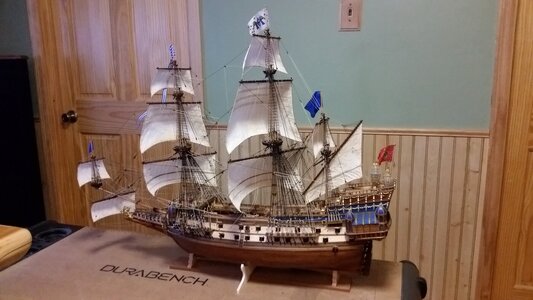Hi Everyone!
One of the challenges in rigging has always been preventing stays from being pulled out of a straight line from tension of back stays and tack lines. If the builder isn't careful, the forestays can be pulled into a curve by the cumulative tension of lines and blocks attached to them. The question becomes, how much deflection from a straight line is acceptable? My guess the answer is, as straight as possible while maintaining the shape of crow's feet for back stays and tension of the tack lines. Higher tension of the stays helps keep them straighter, but too much tension will pull the masts out of alignment. The trick is to balance the tensions between the stays and those lines that are trying to pull them out of a straight line. Since many kits use line thicknesses which are too large for scale, using thinner line, even thread for the thinnest lines on smaller models, for tack and back stay lines can reduce the amount of deflection which the fore stays experience, while keeping tacks and crow's feet nice and taut.
Deflection of forestays is rather extreme in this drawing from 1629.

Scratch Build of La Couronne by Karl Faendrich. Note how carefully he maintained the stays in a straight line.

Some deflection of the main mast forestays is evident here in my model of La Courounne.

One of the challenges in rigging has always been preventing stays from being pulled out of a straight line from tension of back stays and tack lines. If the builder isn't careful, the forestays can be pulled into a curve by the cumulative tension of lines and blocks attached to them. The question becomes, how much deflection from a straight line is acceptable? My guess the answer is, as straight as possible while maintaining the shape of crow's feet for back stays and tension of the tack lines. Higher tension of the stays helps keep them straighter, but too much tension will pull the masts out of alignment. The trick is to balance the tensions between the stays and those lines that are trying to pull them out of a straight line. Since many kits use line thicknesses which are too large for scale, using thinner line, even thread for the thinnest lines on smaller models, for tack and back stay lines can reduce the amount of deflection which the fore stays experience, while keeping tacks and crow's feet nice and taut.
Deflection of forestays is rather extreme in this drawing from 1629.

Scratch Build of La Couronne by Karl Faendrich. Note how carefully he maintained the stays in a straight line.

Some deflection of the main mast forestays is evident here in my model of La Courounne.

Last edited:



